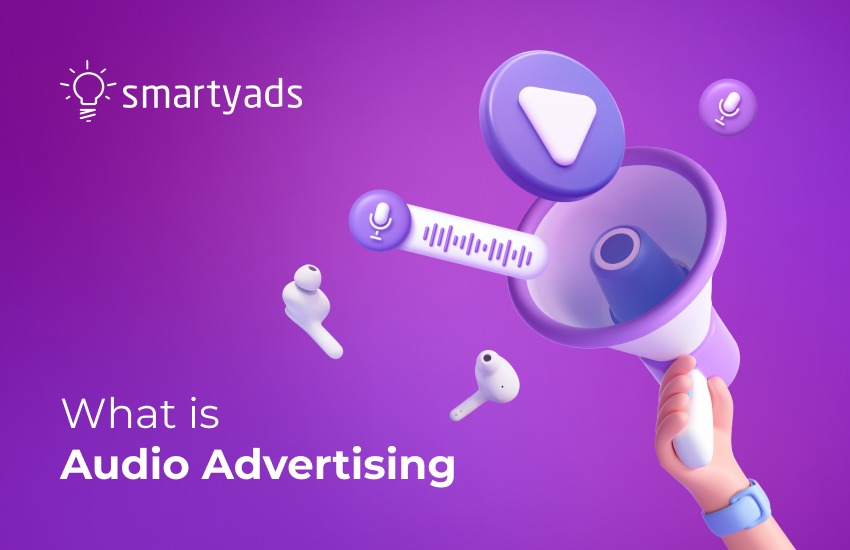Audio advertising is gaining momentum following the growing popularity of music streaming, podcasts, and voice assistants. Promotion in audio formats (both traditional radio and digital) can significantly increase the effectiveness of the media sector.
The global audio advertising market is growing
The global market for audio advertising is growing — a consequence of the growth of audio content consumption worldwide. Audio streaming services are gaining strength, and more diverse content is available on platforms.
According to Hootsuite, a typical Internet user of working age now spends more than an hour a day listening to podcasts.
Globally, the average daily time spent listening to podcasts has increased by 7% over the past year, corresponding to an additional 4 minutes per day.
21.3% of Internet users aged 16 to 64 listen to podcasts weekly, averaging 61 minutes daily.
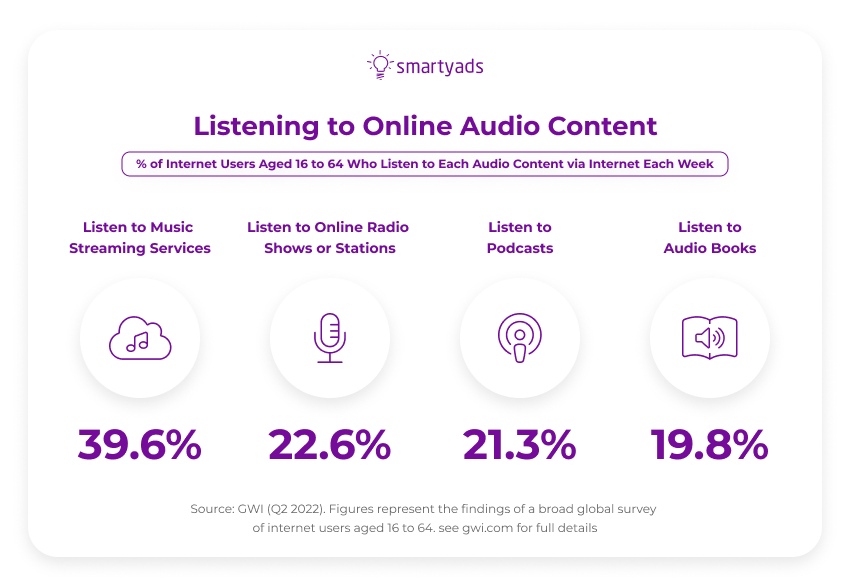
Self-isolation has formed the habit of users around the world to be constantly in touch, listening to colleagues' discussions in the background, and participating in voice dialogues. Therefore, services providing audio content have become more popular.
Apple has announced podcast subscriptions in more than 170 countries.
Spotify has also added podcast subscriptions — unlike Apple, Spotify doesn't charge content creators a commission or a connection fee.
YouTube has added a new advertising tool — audio tracks with a still image or simple animation. Seventy-five percent of the test audio campaigns significantly increased the awareness of the brands advertised. YouTube claims that more than 85% of videos are played in the background.
Facebook announced podcasts and other audio features. According to the announcement, the new services and tools will turn Facebook into a "pocket-sized recording studio".
The popularity of audio ads in Europe
According to IAB Europe, the audio advertising market is experiencing a renaissance. The traditional FM/AM, analog, and DAB advertising market in Europe alone are now worth 6 billion euros. These formats are complemented by new digital audio advertising opportunities — from IP radio and music streaming services to podcasts.
The growth of these new audio services is exponential; there are now about 700,000 podcasts with 29 million episodes, a growth of 27% from last year.
This explosion of content shows no signs of slowing down, and new channels, such as connected cars and radio apps in smart speakers, will help expand opportunities for advertisers to reach listeners.
As a result of new audio services and expanded consumption opportunities, IAB Europe predicts that the European digital audio advertising market will grow to €1.5 billion in 2023.
The benefits of audio advertising
The main benefit of audio advertising is its handiness — people listen to radio or podcasts while driving in the car, jogging, cooking, and in other situations where there is no opportunity to view YouTube videos or recordings on social networks.
Audio ad market: short stats
- Audio ads are cheaper to produce than videos;
- 72% of listeners of audio content pay attention to digital audio ads placed in it;
- Nielsen Media Lab says that more than half (53%) of consumers use free ad-supported audio streaming services (27% subscribe);
- According to the Midroll Media Report, 60% of podcast listeners have made a purchase after listening to an audio ad on a podcast;
- Audio ads can be placed programmatically in digital audio content: podcasts, audio streaming services, and digital radio.
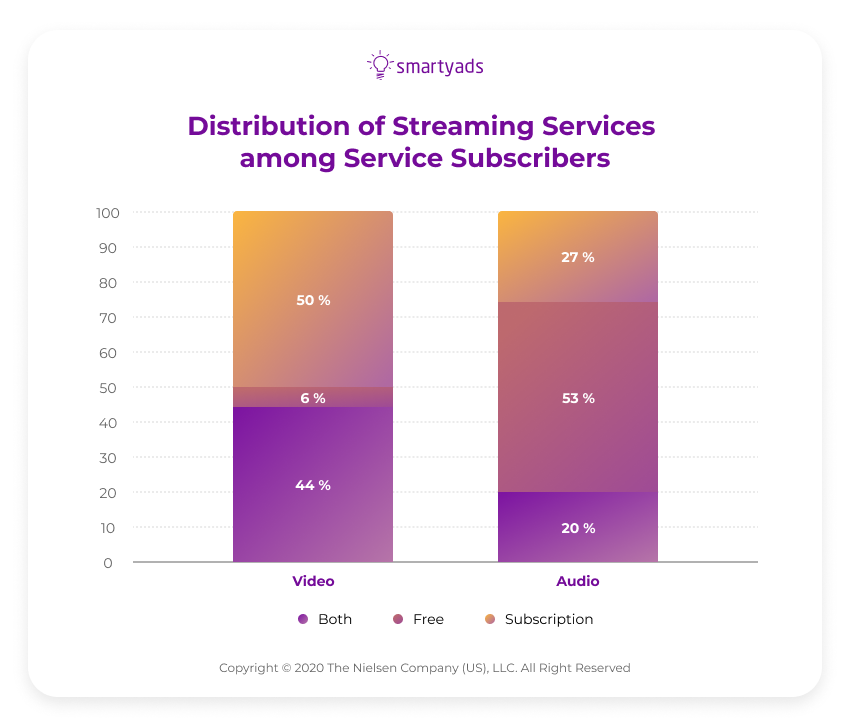
Possible channels of audio promotion
- Traditional radio ads;
- Audio ads in digital audio channels (podcasts, Internet radio, music streaming services, voice assistants, audiobooks).
Radio advertising
Despite the rise of digital audio formats, radio stays with us — and probably will stay as long as there is some traffic.
Statista predicts that worldwide radio ad spend will total approximately $29.3 billion in 2022. Industry projections show that after a downturn in 2020 caused by the effects of the Covid-19 pandemic, the average spend will continue to rebound to more than $30.6 billion in 2024.
Advantages of radio ads
Responsiveness
An audio ad campaign can be launched in a few days faster and easier than on TV. Advertisers appreciate radio for the ability to quickly place ads in audio format, change creative, and complete the placement.
Cost
Many advertisers are attracted by the low cost of contact with the target audience.
Efficiency in media
In addition to other types of advertising activities of the brand, radio advertising or digital
radio advertising increases the effectiveness of advertising campaigns.
Versatility
Radio advertising is suitable for large companies in split with other channels and for advertisers with small budgets — if the campaign is well planned, radio works effectively.
Traditional radio ads are conservative; new formats of such audio ads for the market do not appear because advertisers are tied to the structure of broadcast radio stations.
However, the existence of Internet radio solves many problems. For example, in this case, digital audio ads on the radio can already be placed through the programmatic. It also means that audio advertisements can be run on different types of gadgets, including desktop and mobile devices.
Audio advertising in podcasts and other digital audio formats
Opportunities for marketers to reach audiences with digital audio ads have expanded over the past year. Audio advertising lets marketers reach audiences that aren't available in other channels: busy people with limited time who prefer to listen to an audiobook on the way somewhere instead of watching a video.
Types of Podcast ads
Promotional jingles
A short audio ad that mentions the podcast sponsor. The presenter voices the sponsor at the beginning of the podcast, briefly talks about the brand or product for 2-3 minutes to create brand awareness, and can also recommend clicking on a link in the podcast description or giving a promo code for a discount.
Partner engagement
The presenter talks to the guest from the advertiser's side, usually for about 15 minutes. In this case, the structure of the issue is partly built around the advertiser, and the whole issue turns out to be sort of sponsored. It's similar to sponsored articles, only in an audio format.
Sponsor integration
The entire output of the native is customized to the advertiser, the most expensive and difficult format to produce. The only thing more difficult is to set up the production of your own podcast.
There is no unified tool to assess efficiency yet, each platform has its own analytics system — usually, to understand the coverage, advertisers sum up the figures from all the services where the podcast is posted (e.g., Apple Podcasts, Castbox, Spotify).
Advantages of audio advertising in podcasts
Suitable for any brand
Promotion in podcasts is ideal for complex products and services that need to be detailed and list a lot of conditions. Podcasts are still a recent phenomenon. Their audience is open to new things, so it's more appropriate to promote new products there.
Audio ads in streaming music services are suitable for any advertiser with any advertising message, whether it's a product or a service. The ability to target based on musical interests makes streaming services an ideal platform for promoting artists' concerts.
Quality audience
The cost of contact in podcasts is not low yet, but you can "catch" a very narrow audience for a certain brand and product. Even a small audience can be of high quality; as a rule, people immersed in listening to a podcast will listen to a commercial just as attentively.
Ability to experiment
If you can experiment with podcast audio ads, you should do it. The main thing is not to expect high efficiency and conversion rates, as podcasts are still media for getting acquainted with the brand and product.
Online audio advertising in other digital audio formats is partly gaining momentum (promotion in music streaming) and partly remains a field for experimentation (audio books, voice assistants).
Benefits for the advertiser and for the service
In streaming music services, audio ads inserts are usually included for users who don't have a subscription. But that doesn't mean that audiences who aren't willing to pay for subscriptions aren't paying. Often people have a subscription to one service and are regularly accessing other services in parallel.
For example, you can be subscribed to Spotify but still periodically go to Apple Podcasts to listen to something unique. And then programmatic audio ads will reach you.
How to run audio ads?
It's very easy to do this on SmartyAds. All you need to do is register on SmartyAds DSP, go to your personal cabinet, and then to the campaigns section. The first step is to select the type of campaign — select "Audio".
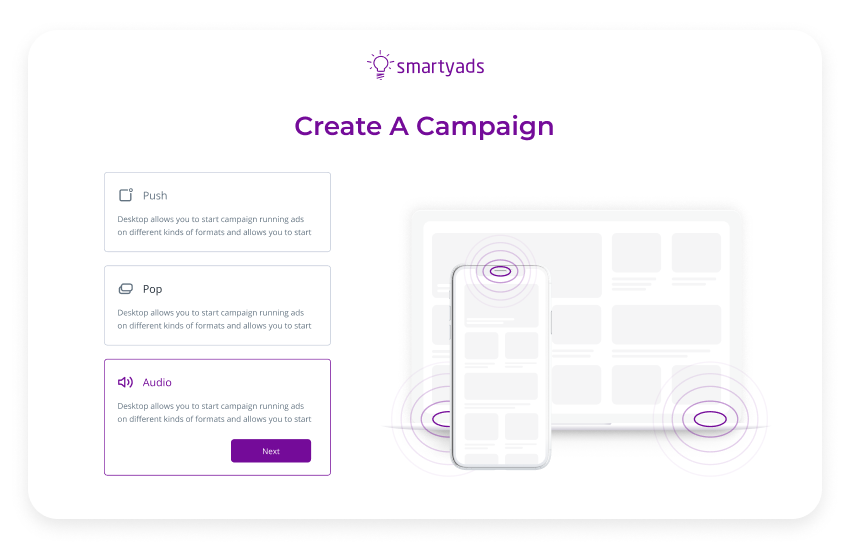
After that, you will need to upload your audio creative.
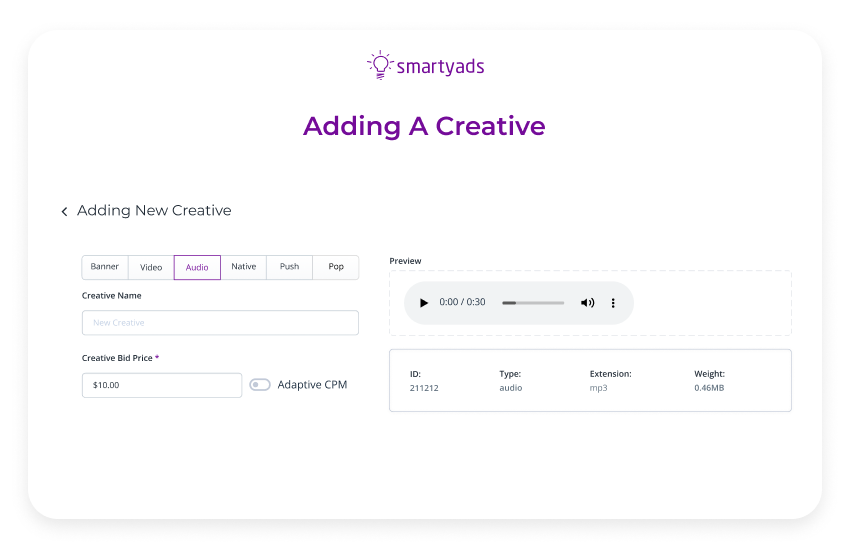
Done! All you need to do is configure your audio campaign settings (region, target audience, and everything like that), and you're ready to run your ads!
This is how it works at SmartyAds; we try to make the whole process as simple and transparent as possible for our customers. We can't vouch for other services, but they probably work similarly.
Conclusions
Audio advertising seems like a familiar song to many marketers that no one will play anymore, but such advertising is a dark horse in the vast field of digital advertising. Many people look at it with caution, and some do not take it into account, not thinking about how much time a modern person spends listening to something.
The emergence of new types of audio content will inevitably entail the emergence of new types of advertising, but so far, it is too early to talk about those.
But if you focus on the existing opportunities, it turns out that digital audio advertising is almost as good as video and banner advertising and, in some ways, even better than those. Besides, audio ads are perfectly compatible with other types of advertising: CTV ads, DOOH ads, in-game ads, etc.
So don't pass by this powerful tool for attracting potential customers to your brand; audio advertising will definitely be a great addition to your marketing strategy.
